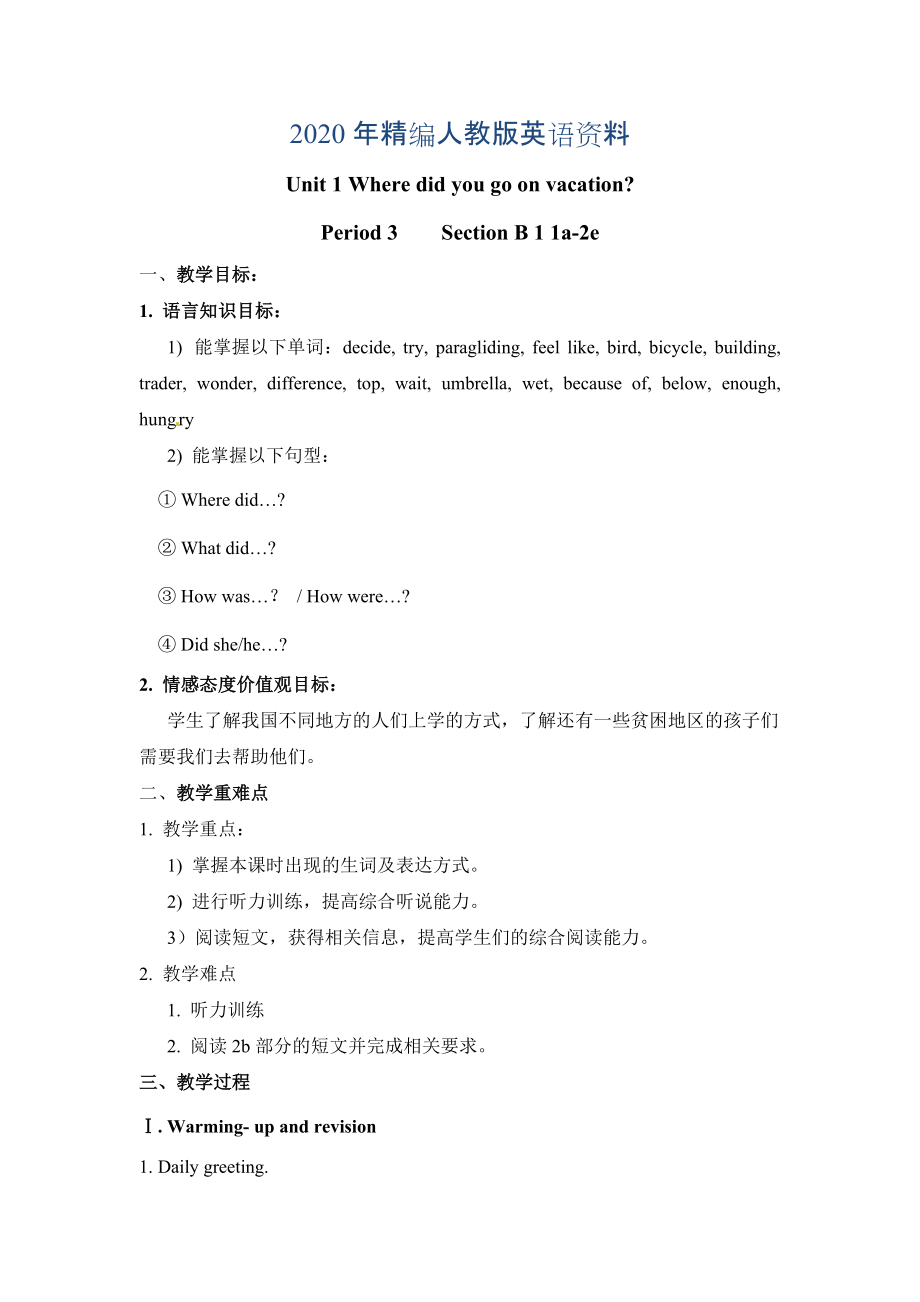《人教版八年級上冊Unit 1 Where did you go on vacation 教案【3】》由會員分享��,可在線閱讀��,更多相關(guān)《人教版八年級上冊Unit 1 Where did you go on vacation 教案【3】(5頁珍藏版)》請在裝配圖網(wǎng)上搜索���。
1�����、2020年精編人教版英語資料
Unit 1 Where did you go on vacation?
Period 3 Section B 1 1a-2e
一����、教學(xué)目標(biāo):
1. 語言知識目標(biāo):
1) 能掌握以下單詞:decide, try, paragliding, feel like, bird, bicycle, building, trader, wonder, difference, top, wait, umbrella, wet, because of, below, enough, hungry
2) 能掌握以下句型:
① Where did…?
2、
② What did…?
③ How was…���? / How were…?
④ Did she/he…?
2. 情感態(tài)度價值觀目標(biāo):
學(xué)生了解我國不同地方的人們上學(xué)的方式���,了解還有一些貧困地區(qū)的孩子們需要我們?nèi)椭麄儭?
二、教學(xué)重難點
1. 教學(xué)重點:
1) 掌握本課時出現(xiàn)的生詞及表達(dá)方式����。
2) 進行聽力訓(xùn)練,提高綜合聽說能力��。
3)閱讀短文����,獲得相關(guān)信息,提高學(xué)生們的綜合閱讀能力��。
2. 教學(xué)難點
1. 聽力訓(xùn)練
2. 閱讀2b部分的短文并完成相關(guān)要求����。
三、教學(xué)過程
Ⅰ. Warming- up and revision
1. Daily
3�、 greeting.
2. Check the homework. Let some Ss report where did they go on vacation.
3. Review the “復(fù)合不定代詞”
4. Review the “反身代詞”
5. Show a movie of paragliding.
Ⅱ. Writing
Work on 1a:
1. Point to the six words. delicious, expensive, exciting, cheap, terrible, boring
2. Read the words a
4���、nd let Ss read after the teacher.
3. Point to the last picture and say: This is a cake. It’s delicious. Then do the same thing for all six pictures.
4. Let Ss match each word with a picture. Then check the answers with the students.
Work on 1b:
1. Explain the meaning of “ J words” and
5、 “ L words.”
2. Let Ss discuss the words they know and write them down on the line.
3. Let some Ss read out their words to the class. (Or let some Ss write their words on the blackboards.)
Ⅲ. Listening
Work on 1c:
1. T: Now let's work on 1c. First, let one student read the questions a
6����、loud. Make sure all the Ss know the meanings of the questions.
2. Play the recording for the first time. Ss only listen.
3. Then play the recording for the second time. Ss listen and answer the questions.
4. Then play the recording for the third time for the Ss to check the answers.
5. Ss lis
7、ten to the tape and circle the words and phrases they hear.
6. Check the answers: (Look at the big screen.)
Work on 1d:
1. Tell Ss this time they have to write down what Lisa said about her vacation, the people, the fun park, the food and the store.
2. Then play the recording for the second
8�、time. Ss listen and write down the words.
3. Then play the recording for the third time for the Ss to check the answers.
聽力指導(dǎo):在聽時要抓重點內(nèi)容。第一次聽要求我們回答問題��,因此在聽的時候����,應(yīng)重點將與這些問題相關(guān)的內(nèi)容方面的聽清���,其他作為非重點內(nèi)容�����。另外�����,要注意要速記下重點內(nèi)容���。
在完成1d部分時要注意聽的重點是放在Lisa對這五個方面的事情所做評價�,因此應(yīng)聽清楚那些形容詞�。
Ⅳ. Pair work
1. Tell Ss to ask and ans
9、wer about Lisa’s vacation. Begin your questions with the following sentences. For example:
Where did you go on vacation?
I went to New York City.
Did you go with anyone?
Yes, I did.
2. Ss work in pairs and ask and answer about Lisa’s vacations.
3. Let some pairs come to the front and ask a
10�����、nd answer in pairs.
Ⅴ. Discussion
1. Tell Ss to work in groups. Discuss the questions together.
What do people usually do on vacation?
What activities do you find enjoyable?
2. Give Ss some possible answers:
People usually go to some places of interest for vacation.
I find fishing
11�、enjoyable.
3. Ss discuss the two questions. Write down their answers. Let some group report their answers.
VI. Reading
Work on 2b:
1. T: Now we’ll read Jane’s diary entries about her vacation and answer the questions.
Did Jane have a good time on Monday?
What about on Tuesday?
2. Ss r
12、ead the diary quickly and find the answers to the questions.
3. Check the answers with the Ss.
Work on 2c:
1. Let some Ss read Jane’s diary entries again. Fill in the chart.
2. Let Ss look at the chart first. Then let them read and fill in the chart.
3. Check the answers. (Look at the big
13��、 screen.)
Work on 2d:
1. Tell Ss they should read the conversation about Jane’s trip to Penang again and use the information in the diary entries.
2. Ss read the conversation about Jane’s trip to Penang first then try to fill in the blanks.
3. 方法指導(dǎo):首先���,應(yīng)讀通讀整個對話一遍�,理解對話的大意����;然后,認(rèn)真閱讀有空格的上下句的內(nèi)容����,結(jié)合日記
14、的內(nèi)容�,確定空格處的內(nèi)容����。 最后�,再通讀一遍對話,綜合日記的內(nèi)容看每個空格處是否貼切��。
3. Ss read carefully and try to write down the words in the blanks.
4. Check the answers with the class.
Work on 2e:
1. 告訴學(xué)生們這篇日記是Jane在七月十八日又一次參觀了Penang Hill 后��,所寫的��。讀日記�����,并用括號中單詞的正確形式填空����。
2. 方法指導(dǎo):首先��,再次明確這是一篇日記����,因此應(yīng)用一般過去時態(tài);然后�����,通讀一遍日記的內(nèi)容,了解大體內(nèi)容����;最后,綜合每句的內(nèi)
15��、容����,用括號中動詞的正確的形式填空。
3. Ss read the diary and try to fill in the blanks.
4. Check the answers. (Look at the big screen)
5. 對動詞一般過去時的規(guī)則形式與不規(guī)則形式�,再復(fù)習(xí)一遍。
Homework
用所給動詞的適當(dāng)形式填空�����。
1. My mother ______ (buy) a new schoolbag for me yesterday.
2. When _____ you _____ (start) to learn English?
3. My aun
16�����、t ______ (take) us to dinner at a restaurant but the food _______ (is) not good at all.
4. When I _______ (am) in America, I _______ (make) a lot of new friends.
5. They _______ (have) a great sale last weekend.
板書設(shè)計:
Section B1 1a-2e
Words: decide, try, paragliding, feel like, bird, bicycle, building, trader, wonder, difference, top, wait, umbrella, wet, because of, below, enough, hungry
① Where did…?
② What did…?
③ How was…�? / How were…?
④ Did she/he…?
Did Jane have a good time on Monday?
What about on Tuesday?
教學(xué)反思
 人教版八年級上冊Unit 1 Where did you go on vacation 教案【3】
人教版八年級上冊Unit 1 Where did you go on vacation 教案【3】

